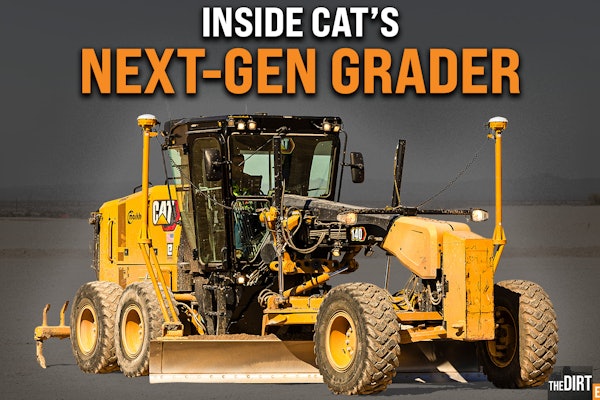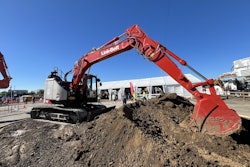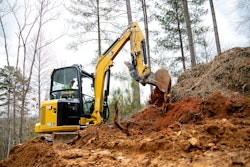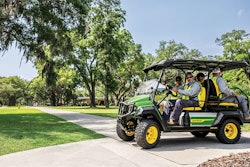Backhoes in the 10- to <14-foot classes are the largest compact models available and are used in a wide array of varying applications. These machines can be found on farms, in landscaping equipment fleets and in hard-core construction applications.
Primary users among construction contractors are companies engaged in light utility, plumbing, electrical and design-and-build landscaping work. "These are contractors who don't necessarily need the 14-foot dig depth or extra reach of larger backhoes," explains Georg Seyrlehner, product manager, backhoe loaders, Ingersoll-Rand. "They typically need to get in and out quickly, move the machine in tight surroundings and dig shallow trenches or load materials."
Many of these jobs once fell squarely in the domain of the skid-steer loader. And manufacturers are quick to point out that skid steers are still the machine of choice for many contactors engaged in these applications. Hard and fast rules for choosing a skid steer or a compact backhoe for these jobs are nonexistent. It's a matter of personal preference for most contractors.
Total operating costs factor into the decision to spec a compact backhoe loader. "A contractor should have a clear understanding of the total per-hour cost of operation of his machine," stresses Jay Barth, product manager, JCB. "Backhoes in these size classes are typically used to complete one step of a larger job – electrical or plumbing installation projects are good examples. If you've got a similar job, and you're not aware of your per-hour cost of operation of the machine – including all factors such as operator, depreciation, insurance, maintenance, etc. – there is no way you can price a job and know whether you're making money. It's also impossible to know if a full-size or compact backhoe will be more productive for you. Further complicating things, the standard rules of productivity, such as feet of trench per hour or tons of material moved with the loader are hard to apply with a compact loader machine in these classes."
For Seyrlehner, the deciding factor is the amount of excavation-style digging you need to do. "In loader applications, skid steers and compact backhoes are evenly matched," he notes. "There are some performance features that can make a difference in specific applications – the backhoe's four-wheel drive or the skid steer's zero-radius turning ability, for example. But if you're doing a lot of digging, the backhoe has a clear edge. Certainly you can use a backhoe attachment on a skid-steer loader. But you're going to have to continuously change that backhoe attachment in and out, whereas you only have to reverse the seat on the backhoe."
"Talking about productivity with compact backhoes can get a little abstract," admits Paul Anderson, product marketing manager, Bobcat. "But some general rules do apply." Simply observing a machine's usage rate can tell you a lot about its role in your fleet, he explains. If the machine is properly sized for your applications, Anderson says it will generally be working all the time. "Some of that goes back to taking advantage of proper attachment use," he adds. "If you've got the backhoe work done, remember that machine can still be put to work doing a little landscaping or moving materials with the front end of the machine."
But a compact backhoe's flexibility isn't defined by attachment usage alone, as Glenn Wright, product marketing manager, John Deere, points out. "The thing that's unique about the backhoe loader is that it's a tractor in a sense," he explains. "Indeed, the original name for these machines was 'tractor loader backhoe.' On many backhoes you can drop off the backhoe. On a Deere machine, it takes about two minutes to do it." Once the backhoe is removed, you then have access to the machine's three-point hitch. This lets you run any Category 1 three-point hitch implement off the rear PTO. So if you're doing foundation work, you can put on a box blade with hydraulically controlled top end tilt. Or you can add mowers, plows – a whole host of implements not normally associated with construction applications."
Despite their size, these “compact” machines can tackle many tasks traditionally handled by larger backhoes.
Hydrostat drives spawn a host of specialized functions
More big-machine features are finding their way onto compact backhoes. Hydrostatic transmissions are one of them. Many contractors prefer compact backhoes with mechanical gearboxes. They are generally cheaper to produce, purchase and repair. And many contractors feel they’re more rugged in compact construction applications.
Hydrostat drivetrains proponents dispute this, noting that hydrostat units have proven to be at least as durable as mechanical units in real-world working conditions. And while it’s true that hydrostatic units are somewhat more expensive to purchase and repair, manufacturers claim these added costs are more than offset by the marked increase in productivity they deliver.
For one thing, hydrostatic units don’t require the operator to manually shift gears, so they’re easier machines to run. This removes the potential for operator error and makes the backhoe easier for new operators to handle and use productively. “The other thing about hydrostatic drives is they allow us, as manufacturers, to build in production-enhancing performance features that can dramatically boost performance,” Wright says.
One such feature he points to is Deere’s Loadmatch control system. “Our engineers added an electronic control module that adjusts the slosh plate angle on the transmission to counter varying power requirements,” Wright explains. “In the real world, this means that if the engine bogs down as you enter a pile of heavy material, the transmission will automatically adjust horsepower and torque so that it doesn’t stall out.”
A backhoe’s hydrostat system provides an infinitely variable torque rise throughout the engine’s power curve. Wright says Deere engineers took advantage of this performance trait to add a creeper function that gives operators extremely fine control of the backhoe’s transmission. “The creeper function simplifies small machine movements and corrections when trenching or digging with the backhoe,” he explains. “When the system is activated, all you have to do when you want to reposition the machine is lift up the stabilizers and step on the creeper pedal. The transmission will roll you forward or backward and you don’t have to push the machine with the stick.”
Attachment use is an easy way to increase a backhoe’s overall productivity level.
Spec’ing a complete backhoe package
“Good backhoe power is a function of the machine’s hydraulic system and should be a primary concern when you’re sizing up a machine,” says Lance Mathern, product marketing manager, Bobcat. “A combination of factors directly affects backhoe digging performance – things like cylinder balance, hydraulic flow and pressure and the necessary engine horsepower to support all those aspects.” Still, rating all those factors can be difficult to do. For that reason, Mathern suggests simply checking a potential machine’s bottom-line breakout force and cycle time numbers. “Those are the primary factors to measure when you’re concerned about backhoe performance,” he notes. “These numbers boil the impact of those performance factors down to their essence and give you hard data when comparing digging performance between machines.”









